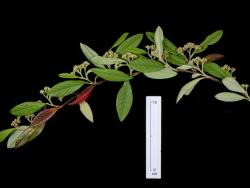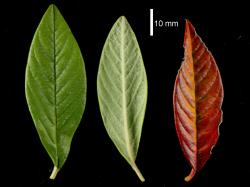Shrub or small tree, 2–4 m tall, evergreen. Branchlets dark purple, glossy, with peeling cuticle and lenticels. Stipules not persisting, 2.3–5.0 mm long, red, hairs dense. Leaves narrowly elliptic, plane, 70–84 mm long, lamina 67–80 mm long, 21–22 mm wide, veins in 10–13 pairs, lamina 300–320 µm thick, petiole 3–6 mm long with dense, fine, yellow, frizzy hairs; midvein and lateral veins impressed above and projecting below, moderately rugose due to lamina being convex between the side veins, upper surface moderately glossy, young leaves not seen, old leaves glabrous on upper surface except along the midvein; margins recurved, glabrous on old leaves; undersurface glaucous, hairs sparse when old except on the midvein, where they remain dense; base of lamina cuneate; apex acute with straight apiculus.
Inflorescence a compound corymb, c. 15–17 fruit per corymb, rachis hairs dense, pale yellow. Pedicels 1.5–2.0 mm long, hairs dense. Flowers not seen. Fruit crimson, spherical, 6.0–6.8 mm long, 6.0–7.0 mm diameter, hairs on mature fruit absent, navel closed; pyrenes (2)3–4, 3.0–5.3 mm long, 2.5–3.5 mm wide, hairs sparse, apex rounded, style attached at apex.
Shrub or small tree 6–8 m tall. Branches arched. Leaves evergreen, leathery, 40–90 × 13–23 mm, narrowly ovate. Petiole often red. Upper leaf surface dark green, initially sparsely hairy, 7–12 pairs of deeply impressed veins, leaf margins recurved, lower surface glaucous, initially densely pilose. Flowers 10–50 per corymb, petals white and spreading, glabrous, filaments white, anthers purple. Pyrenes (2)3–4, style at pyrene apex.
Most similar to Cotoneaster ×watereri, the hybrid which has C. salicifolius as one of its parents.
Cotoneaster salicifolius has a leaf lamina 60–85 mm long, 18–22 mm wide, the leaves are fairly strongly rugose, and have a dry uncompressed fruit diameter 4.2–7.0 mm. Most C. ×watereri plants have a leaf lamina 90–135 mm long × 23–40 mm wide, weakly or not rugose, and have a dry uncompressed fruit diameter of 5.7–8.0 mm and a fresh fruit diameter of 10–11 mm.
Plants with a leaf lamina 60–90 mm long may be either C. salicifolius or C. ×watereri, and the only way of identifying these small-leaved plants in the absence of fruit seems to be the degree of rugosity, which is stronger in C. salicifolius.
Cotoneaster coriaceus is persistently hairy on the lower leaf surface below while C. salicifolius loses its hairs with leaf age. The leaves of C. salicifolius are narrowly elliptic, not obovate. Leaves of C. coriaceus are 31–50 mm wide, vs. C. salicifolius 18–22 mm wide. Flowers do not differ. Pyrene number is 2–3 in C. salicifolius, 2 in C. coriaceus, but the style in C. salicifolius attaches at the pyrene apex, not 0.4–0.8 mm below the apex.
Very similar to Cotoneaster hylmoei. The two are probably indistinguishable without flowers. The petals of C. salicifolius are white and spreading, while in C. hylmoei they are pink and semi-spreading.
Known wild from only the Lake Wānaka site. In cultivation in Christchurch (1962) and Port Hills—Victoria Park (1987).
CHR 534889, P.N. Johnson 1433, 12 Feb. 2000, Lake Wānaka, Dublin Bay.
Flowering: not known; Fruit: February to May
Diploid (Fryer & Hylmö 2009)





